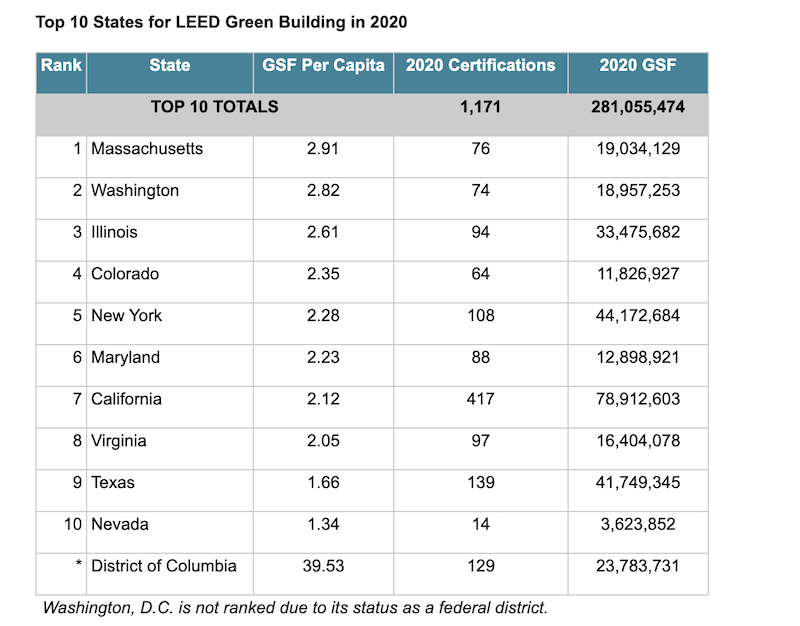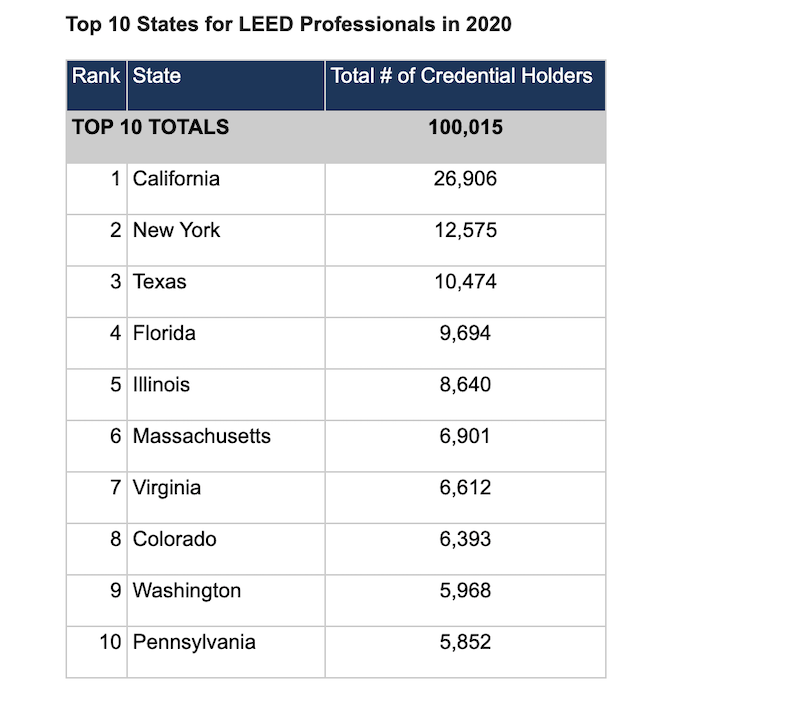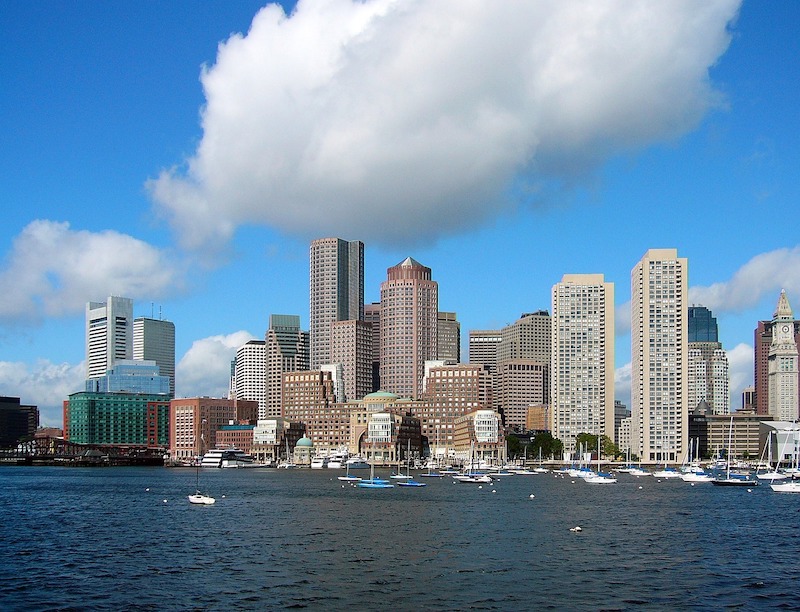The U.S. Green Building Council (USGBC) released its annual list of the Top 10 States for LEED green building with Massachusetts leading the country in 2020 with the most certified square feet per capita. Across the top states, more than 60% of certifications were office, healthcare, higher education and K-12 projects. This year, USGBC also released a ranking of states with the most LEED professionals with California taking the top spot. Collectively, the 2020 rankings represent 1,171 certified LEED buildings and spaces, and more than 100,000 green building workers.
“If we are to rebuild an economy that supports our health and our planet, we must lead with changing the way we design and build,” said Mahesh Ramanujam, president and CEO of USGBC. “Last year was a stark reminder that the quality of our buildings impacts the quality of our life. Looking ahead, people want to trust that the spaces they occupy are good for them and their communities, and LEED has always been a tool to support those goals. Now is the time to ensure that every building is LEED certified as that is the only way we are accomplishing our goals of access to healthy, green buildings, homes and spaces.”
While offices, education and healthcare projects accounted for a majority of certifications, warehouses, distribution centers, multifamily and retail projects represented almost 20%. Also, almost half of all projects were certified Gold, indicating a commitment to a high level of certification.
The Top 10 States for LEED green building is based on gross square feet of certified space per person using 2010 U.S. Census data and includes commercial and institutional projects certified in 2020. The full top 10 state rankings are as follows:

The global green building community is continually improving LEED to ensure it helps buildings, communities and cities to be more sustainable, healthy, resilient and equitable. More than two-thirds of LEED credits support human health, as the rating system addresses ventilation and filtration, daylighting, low-emitting materials, access to outdoor spaces, acoustics and other key factors. In response to the COVID-19 pandemic, USGBC also introduced Safety First guidance to address operational challenges and assist with each state’s re-entry planning.
LEED’s foundation, however, is in its commitment to help the building sector reduce its contribution to climate change. Certification communicates progress in support of climate and ESG commitments and the goal is to get more buildings on a path to certify. Using Arc to track performance, USGBC is tracking nearly 56 million metrics tons of GHG emissions associated with energy and transportation, and more than 167 billion gallons of water. The data show that LEED projects deliver significant reductions in emissions and improvements in occupant experience - and the benefits increase with higher levels of LEED certification. The latest version of the rating system, LEED v4.1, raises the bar on green building performance, defining the latest sustainability standards while enabling project teams to continue to track progress beyond certification.
“If we want to make a positive impact in our communities, we must transform the building sector, and focus on what the data is telling us,” added Ramanujam. “By putting data at the center of LEED we’re helping teams better understand building performance, find ways to improve and ultimately find a path to net zero.”
Since 2018, more than 25 projects globally have certified LEED Zero, which recognizes net zero performance in buildings and spaces. LEED’s third-party certification is the industry’s dominant green building standard and LEED Zero expands on that work verifying achievements in net zero carbon, energy, water and waste. It focuses on a higher level of green building performance.
Transforming the building sector to be more sustainable requires a skilled and knowledgeable workforce. This workforce is contributing to the development and advocacy of LEED and is being quickly embraced by the next generation workforce and decision makers. USGBC has been committed to cultivating and supporting green building professionals through its credentialing and certificate programs. This year, USGBC is also releasing an additional Top 10 list recognizing states with the most LEED green building professionals. The full list is as follows:

More information about LEED certification and green building is available at usgbc.org.
Related Stories
Industry Research | Jan 23, 2024
Leading economists forecast 4% growth in construction spending for nonresidential buildings in 2024
Spending on nonresidential buildings will see a modest 4% increase in 2024, after increasing by more than 20% last year according to The American Institute of Architects’ latest Consensus Construction Forecast. The pace will slow to just over 1% growth in 2025, a marked difference from the strong performance in 2023.
Construction Costs | Jan 22, 2024
Construction material prices continue to normalize despite ongoing challenges
Gordian’s most recent Quarterly Construction Cost Insights Report for Q4 2023 describes an industry still attempting to recover from the impact of COVID. This was complicated by inflation, weather, and geopolitical factors that resulted in widespread pricing adjustments throughout the construction materials industries.
Hotel Facilities | Jan 22, 2024
U.S. hotel construction is booming, with a record-high 5,964 projects in the pipeline
The hotel construction pipeline hit record project counts at Q4, with the addition of 260 projects and 21,287 rooms over last quarter, according to Lodging Econometrics.
Multifamily Housing | Jan 15, 2024
Multifamily rent growth rate unchanged at 0.3%
The National Multifamily Report by Yardi Matrix highlights the highs and lows of the multifamily market in 2023. Despite strong demand, rent growth remained unchanged at 0.3 percent.
Self-Storage Facilities | Jan 5, 2024
The state of self-storage in early 2024
As the housing market cools down, storage facilities suffer from lower occupancy and falling rates, according to the December 2023 Yardi Matrix National Self Storage Report.
Designers | Dec 25, 2023
Redefining the workplace is a central theme in Gensler’s latest Design Report
The firm identifies eight mega trends that mostly stress human connections.
Contractors | Dec 12, 2023
The average U.S. contractor has 8.5 months worth of construction work in the pipeline, as of November 2023
Associated Builders and Contractors reported today that its Construction Backlog Indicator inched up to 8.5 months in November from 8.4 months in October, according to an ABC member survey conducted Nov. 20 to Dec. 4. The reading is down 0.7 months from November 2022.
Market Data | Nov 27, 2023
Number of employees returning to the office varies significantly by city
While the return-to-the-office trend is felt across the country, the percentage of employees moving back to their offices varies significantly according to geography, according to Eptura’s Q3 Workplace Index.
Market Data | Nov 14, 2023
The average U.S. contractor has 8.4 months worth of construction work in the pipeline, as of September 2023
Associated Builders and Contractors reported that its Construction Backlog Indicator declined to 8.4 months in October from 9.0 months in September, according to an ABC member survey conducted from Oct. 19 to Nov. 2. The reading is down 0.4 months from October 2022. Backlog now stands at its lowest level since the first quarter of 2022.
Multifamily Housing | Nov 9, 2023
Multifamily project completions forecast to slow starting 2026
Yardi Matrix has released its Q4 2023 Multifamily Supply Forecast, emphasizing a short-term spike and plateau of new construction.

















